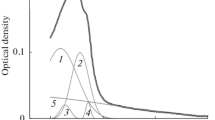Abstract
Time resolved fluorescence was used to study the dynamics on the nanosecond and subnanosecond time scale of the peptide hormone motilin. The peptide is composed of 22 amino acid residues and has one tyrosine residue in position 7, which was used as an intrinsic fluorescence probe. The measurements show that two rotational correlation times, decreasing with increasing temperature, are needed to account for the fluorescence polarization anisotropy decay data. Viscosity measurements combined with the fluorescence measurements show that the rotational correlation times vary approximately as viscosity with temperature. The shorter rotational correlation time (0.08 ns in an aqueous solution with 30% hexafluoropropanol, HFP at 20°C) should be related to internal movement of the tyrosine side chain in the peptide while the longer rotational correlation time (2.2 ns in 30% HFP at 20°C) describes the motion of the whole peptide. In addition, the interaction of motilin or the derivative motilin (Y7F) −23W (with tyrosine substituted by phenylalanine and with a tryptophan fluorophore added to the C-terminal) with negatively charged phospholipid vesicles (DOPG) was studied. The results show the development of a long anisotropy decay time which reflects partial immobilization of the peptide by interaction with the vesicles.
Similar content being viewed by others
References
Allard P, Jarvet J, Ehrenberg A, Gräslund A (1995) Mapping of the spectral density function of a Cα–Hα bond vector from NMR relaxation rates of a 13C labelled a-carbon in motilin. J Biomol NMR (in press)
Backlund B-M, Gräslund A (1992) Structure and dynamics of motilin. Time-resolved fluorescence of a peptide hormone with a single tyrosine residue. Biophys Chem 45:17–25
Backlund B-M, Wikander G, Peeters TL, Graslund A (1994) Induction of secondary structure in the peptide hormone motilin by interaction with phospholipid vesicles. Biochim Biophys Acta 1190:337–344
Claesens F, Rigler R (1986) Conformational dynamics of the anticodon loop in yeast tRNAPhe as sensed by the fluorescence of wybutine. Eur Biophys J 13:331–342
Cantor CR, Schimmel PR (1980) Biophysical Chemistry, part 2. Freeman, New York, p 461
DeLoof H, Nilsson L, Rigler R (1992) Molecular dynamics simulation of galanin in aqueous and nonaqueous solution. J Am Chem Soc 114:4082–4035
Edmondson S, Khan N, Shriver J, Zdunek J, Graslund A (1991) The Solution Structure of Motilin from NMR Distance Constraints, Distance Geometry, Molecular Dynamics, and an Iterative Full Relaxation Matrix Refinement. Biochemistry 30:11271–11279
Gräslund A, Kim SK, Eriksson S, Nordén B, Jernström B (1992) Dynamics of benzo[a] pyrene diol epoxide adducts in poly(dGdC) · (dG-dC) studied by synchrotron excited fluorescence polarization anisotropy decay. Biophys Chem 44:21–28
Kemple MD, Yuan P, Nollet K, Fuchs JA, Silva N, Prendergast FG (1994) 13C NMR and fluorescence analysis of tryptophan dynamics in wild-type and two single-trp variants of Escherichia coli thioredoxin. Biophys J 66:2111–2126
Kinosita JR K, Kawato S, Ikegami A (1977) A theory of fluorescence polarization decay in membranes. Biophys J 20:289–305
Khan N, Graslund A, Ehrenberg A, Shriver J (1990) Sequence-Specific 1H NMR Assignments and Secondary Structure of Porcine Motilin. Biochemistry 29:5743–5751
Lakowicz JR, Gryczynski I, Laczko G, Wiczk W (1993) Intensity and anisotropy decays of [Leu5] enkephalin tyrosyl fluorescence by 10 GHz frequency-domain fluorometry. Biophys Chem 47:33–40
Lipari G, Szabo A (1982) Model-free approach to the interpretation of nuclear magnetic resonance relaxation in macromolecules 1. Theory and range of validity. J Am Chem Soc 104:4546–4559
MacKerell Jr AD, Rigler R, Nilsson L, Hahn U, Saenger W (1987) Protein dynamics: A time-resolved fluorescence, energetic and molecular dynamics study of ribonuclease T1. Biophys Chem 26:247–261
Palmer III AG, Hochstrasser RA, Millar DP, Rance M, Wright PE (1993) Characterization of amino acid side chain dynamics in a zinc finger peptide using 13C NMR spectroscopy and time-resolved fluorescence spectroscopy. J Am Chem Soc 115:6333–6345
Rigler R, Ehrenberg M (1973) Molecular interactions and structure as analysed by fluorescence relaxation spectroscopy. Quart Rev Biophys 6:139–199
Rigler R, Kristensen O, Roslund J, Thyberg P, Oba K, Eriksson M (1987) Molecular structures and dynamics: Beamline for time resolved spectroscopy at the MAX synchrotron in Lund. Phys Scr T17:204–208
Author information
Authors and Affiliations
Additional information
Correspondence to: A. Gräslund
Rights and permissions
About this article
Cite this article
Backlund, BM., Kulinski, T., Rigler, R. et al. Dynamics of the peptide hormone motilin studied by time resolved fluorescence spectroscopy. Eur Biophys J 23, 407–412 (1995). https://doi.org/10.1007/BF00196827
Received:
Accepted:
Issue Date:
DOI: https://doi.org/10.1007/BF00196827




